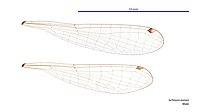Ischnura aurora
| Golden dartlet | |
|---|---|

| |
| male | |
| Scientific classification | |
| Kingdom: | Animalia |
| Phylum: | Arthropoda |
| Class: | Insecta |
| Order: | Odonata |
| Suborder: | Zygoptera |
| Family: | Coenagrionidae |
| Genus: | Ischnura |
| Species: | I. aurora
|
| Binomial name | |
| Ischnura aurora | |

| |
| Synonyms | |
| |
Ischnura aurora,[3][1] golden dartlet, also known as the aurora bluetail,[4] is a species of damselfly in the family Coenagrionidae.[1][5]
Adults[]
A small apple green damselfly with black thoracic stripes and blue tipped yellow tail.[1]
Male
Eyes: Black half moon like cap above, olive green to dark olive below, which fade to pale olive beneath. Two azure blue spots are present behind the eyes. Thorax: Shining black with two pale grass green stripes. Sides are light green and white below. Legs: Pale greenish white with vertical stripe on femur, just above femur - tibia joint. Wings: Transparent. Wing spot: The wing spots are different in fore and hindwings. It is rose-red in forewings and uniform pale grey in hindwings. Abdomen: Bright reddish yellow. The second and seventh segments has upper narrow and broad black marks respectively.[1] Only 1/3 of length of segment 8 and full length of segment 9 tergite are blue. The base color of the segment 8 tergite is melanic black.[6]
Female
Eyes: Brown half moon like cap above, green to pale green below. Thorax: Shining black with two orange stripes. Sides are pale green. Legs: Pale white with vertical black stripes on femur, just above femur - tibia joint. Abdomen: A broad black stripe runs along the upper side of abdomen. Segments 8 - 10 do not have azure blue markings.[1]
Habitat[]
Found among vegetation along the banks of ponds, rivers, canals, marshes and wet rice fields.[1]
Distribution[]
Distributed from Australia, Pacific Islands, East Asia and Southeast Asia.[1] There are strong differences in DNA between the Asian forms of the species and specimens from the Pacific.[1] The form found in Indian subcontinent and Iran is Ischnura aurora rubilio Selys, 1876 and is now considered as a different taxon, Ischnura rubilio.[7]
Gallery[]

Male in Australia

Illustration of Ischnura aurora wing

Photo of female wings

Photo of male wings
See also[]
References[]
- ^ a b c d e f g h i Dow, R.A.; Rowe, R.; Marinov, M. (2020). "Ischnura aurora". IUCN Red List of Threatened Species. 2020: e.T167375A83371053. doi:10.2305/IUCN.UK.2020-1.RLTS.T167375A83371053.en. Retrieved 19 November 2021.
- ^ Brauer, F. (1865). "Dritter Bericht über die auf der Weltfahrt der kais. Fregatte Novara gesammelten Libellulinen". Verhandlungen der Zoologisch-Botanischen Gesellschaft in Wien (in German). 15: 501–512 [510] – via Biodiversity Heritage Library.
- ^ "World Odonata List". Slater Museum of Natural History. Retrieved 2017-03-03.
- ^ Theischinger, Gunther; Hawking, John (2006). The Complete Field Guide to Dragonflies of Australia. Collingwood Vic.: CSIRO. p. 96. ISBN 978-0643090736.
- ^ "Species Ischnura aurora (Brauer, 1865)". Australian Faunal Directory. Australian Biological Resources Study. 2012. Retrieved 8 April 2017.
- ^ Rj, Rowe (2010-08-13). "Ischnura aurora (Brauer 1865) (Zygoptera: Coenagrionidae), an Australo-Pacific species". New Zealand Journal of Zoology. 37, 2010 - Issue 2 (2): 189–192. doi:10.1080/03014223.2010.488789.
- ^ DUMONT, H.J. (December 2013). "PHYLOGENY OF THE GENUS ISCHNURA, WITH EMPHASIS ON THE OLD WORLD TAXA (ZYGOPTERA: COENAGRIONIDAE)" (PDF). Odonatologica. 42 (4): 301–308.
External links[]
![]() Data related to Ischnura aurora at Wikispecies
Data related to Ischnura aurora at Wikispecies
![]() Media related to Ischnura aurora at Wikimedia Commons
Media related to Ischnura aurora at Wikimedia Commons
- IUCN Red List least concern species
- Ischnura
- Odonata of Australia
- Odonata of Oceania
- Insects of Australia
- Taxa named by Friedrich Moritz Brauer
- Insects described in 1865
- Damselflies




